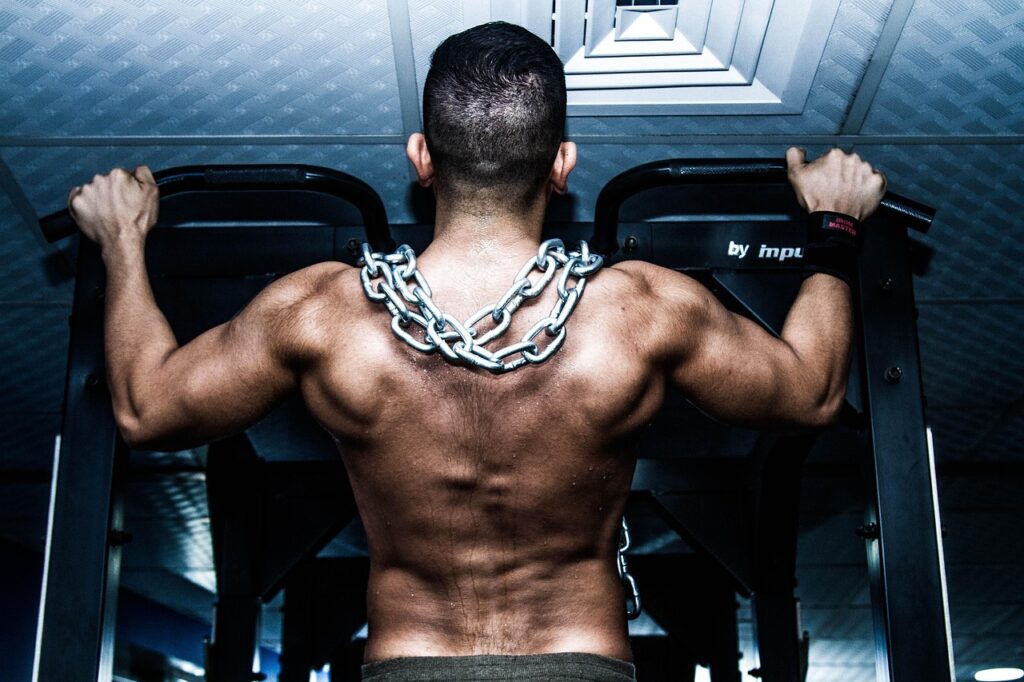The latissimus dorsi—commonly known as the “lats”—are key to building a wide, powerful back. From chin-ups to barbell rows, most pulling movements involve the lats to some degree. But without a deeper understanding of how this large, complex muscle works, many lifters end up over-relying on their biceps, traps, or rear delts—missing the mark on true lat development.
To optimize your back training, you must learn how the back muscle anatomy and biomechanics of the lats guide smarter programming, better execution, and ultimately, more muscular growth.
Functional Anatomy of the Lats
The latissimus dorsi is a broad, flat muscle originating from the mid-to-lower spine (T7–T12), thoracolumbar fascia, iliac crest of the pelvis, and lower ribs. It inserts into the front side of the upper arm (humerus), wrapping underneath the armpit. This long, sweeping structure allows it to influence multiple joints.
Primary Functions:
- Shoulder extension: Pulling the arm back from a flexed position
- Shoulder adduction: Bringing the arm down toward the body
- Internal rotation of the shoulder
The lats also contribute to postural support through their connection to the thoracolumbar fascia, linking the upper body to the pelvis and spine. This anatomical bridge makes the lats a stabilizing muscle during many compound lifts.
Due to its fan-like fiber arrangement, different portions of the lats are emphasized depending on the direction of the pull:
- Upper fibers: respond better to horizontal or high-to-low angles (e.g., incline rows)
- Middle fibers: activated with standard vertical pulls (e.g., neutral grip pulldowns)
- Lower fibers: emphasized with deep shoulder extension (e.g., straight-arm pulldowns)
Best Lat Exercises Backed by Science
While nearly all pulling exercises involve the lats to some degree, few isolate them effectively. Precision matters. Here’s how research helps identify the best lat exercises based on EMG data and biomechanical principles.
1. Vertical Pulls: Maximize Length and Stretch
- Pull-Ups (neutral or underhand grip)
EMG analysis shows strong lat activation, particularly when using a shoulder-width grip and maintaining scapular depression (Signorile et al., 2002). Underhand and neutral grips reduce biceps dominance and promote elbow paths that better align with lat fibers (Schoenfeld et al., 2009). - Lat Pulldowns (lean-back variation)
Pulldowns with a ~30° lean and a neutral grip outperform wide-grip pulldowns in activating the latissimus dorsi, especially when the elbows are pulled downward and inward (Lusk et al., 2010; Paoli et al., 2009). - Straight-Arm Pulldowns
EMG studies show high lower lat engagement due to full shoulder flexion and minimal elbow flexion, isolating lat extension without biceps interference (Andersen et al., 2006).
2. Horizontal Pulls: Emphasize Thickness and Upper Fibers
- Chest-Supported Dumbbell Rows
Support eliminates body sway and ensures controlled scapular retraction. When performed with elbows close to the body, these rows emphasize mid-lat fibers (Schoenfeld et al., 2014). - One-Arm Dumbbell Rows (low elbow path)
Pulling with the elbow close to the torso reduces trap involvement and enhances lat engagement. EMG activity increases when the elbow path mimics shoulder extension rather than abduction (McAllister et al., 2014). - Seal Rows or Machine Rows
Like chest-supported rows, seal rows reduce momentum and ensure lat loading through scapular depression and adduction. The fixed position encourages consistent elbow trajectory.
3. Pull-Over Variations
- Cable Pullovers or Dumbbell Pullovers
Effective for lengthening the lats under load. Recent evidence suggests that exercises placing muscles under stretch (like pullovers) may enhance hypertrophy via mechanical tension and passive force (Warneke et al., 2022; Pedrosa et al., 2023).
Optimizing Form for Lat Activation
Key technique points for maximizing lat engagement:
- Elbow path: Pull elbows down and in, not back and wide (Paoli et al., 2009)
- Grip: Neutral or slightly supinated grips often align better with lat fiber orientation (Lusk et al., 2010)
- Scapular control: Actively depress the scapulae to reduce trap involvement and target the lats (Schoenfeld et al., 2009)
- Torso angle: Leaning back slightly in vertical pulls aligns better with the lats’ line of pull (McAllister et al., 2014)
Common Compensation Patterns
- Biceps Dominance: Excessive elbow flexion shifts the load from lats to biceps (Schoenfeld et al., 2010)
- Trap Overactivation: Poor scapular control leads to shrugging and upper trap dominance (Paoli et al., 2009)
- Torso Swinging: Momentum reduces mechanical tension and active contraction of the lats (Schoenfeld et al., 2014)
Lat-Focused Training Programs
To optimize hypertrophy, consider structuring your training to target specific lat regions or include a comprehensive approach. Here’s how:
Sample Program 1: Lower Lats Emphasis
| Exercise | Sets | Reps |
|---|---|---|
| Straight-Arm Pulldowns | 3 | 12–15 |
| Neutral-Grip Pull-Ups | 3 | 6–10 |
| One-Arm Dumbbell Row (low elbow path) | 4 | 8–10 |
| Cable Pullovers (Loaded Stretch) | 2 | 15–20 |
Focus: Exercises emphasizing deep shoulder extension and vertical pulling for lower lat hypertrophy (McAllister et al., 2014; Warneke et al., 2022)
Sample Program 2: Upper & Mid Lats Emphasis
| Exercise | Sets | Reps |
|---|---|---|
| Incline Chest-Supported Rows | 3 | 8–10 |
| Supinated-Grip Lat Pulldown | 4 | 10–12 |
| Seal Rows | 3 | 10 |
| Dumbbell Pullovers (Slow Eccentric) | 2 | 12–15 |
Focus: Horizontal pulling with controlled elbow positioning to bias upper lat fibers (Schoenfeld et al., 2014)
Sample Program 3: Complete Lat Development
| Exercise | Sets | Reps |
|---|---|---|
| Straight-Arm Pulldown (activation) | 2 | 15–20 |
| Pull-Ups (Neutral or Underhand) | 3 | AMRAP (form strict) |
| Lat Pulldown (lean-back variation) | 3 | 10–12 |
| One-Arm Dumbbell Row (hip-focused elbow path) | 3 | 8–10 |
| Incline Chest-Supported Row | 3 | 10 |
| Cable Pullover (Loaded Stretch Hold) | 2 | 30s hold |
Focus: Combine vertical and horizontal vectors with loaded stretching for total lat activation (Pedrosa et al., 2023; Warneke et al., 2022)
Stretching and Mobility for the Lats
Stretching the latissimus dorsi enhances posture, range of motion, and training efficiency. Tight lats restrict overhead movement and compromise shoulder mechanics.
Key Lat Stretches:
- Overhead Hanging Stretch
Lengthens the lats and decompresses the spine. Use side-bias for unilateral emphasis. - Wall Lat Stretch
Opens the shoulder and upper thoracic region, ideal for pre-lift mobility. - Band-Assisted Side Stretch
Provides gentle traction while lengthening the lat across multiple planes.
Thoracic Mobility
Limited thoracic extension restricts full shoulder flexion, keeping the lats shortened. Improving thoracic mobility enables full lat lengthening during training and stretching (Kaneoka et al., 2007).
Loaded Stretching and Hypertrophy
Recent studies show loaded stretching significantly contributes to muscle growth, likely via increased mechanical tension and sarcomerogenesis (Warneke et al., 2022; Pedrosa et al., 2023).
- Example: Hold the bottom of a cable pullover for 30–60 seconds post-set to stretch the lats under load.
Conclusion
The latissimus dorsi is more than just a pulling muscle—it’s the cornerstone of back aesthetics, strength, and structural integrity. Unlocking its full potential requires more than just effort—it demands strategy.
By combining anatomical understanding, evidence-based exercise selection, and mobility practices, lifters can maximize lat development across all angles. Don’t just pull harder. Pull smarter.
References:
- Andersen, V., Fimland, M. S., Wiik, E., et al. (2006). Muscle activation and strength in one- and two-arm pull-down exercises. Journal of Strength and Conditioning Research.
- Kaneoka, K., Shimizu, K., & Hangai, M. (2007). Lumbar and thoracic spine mobility and low back pain. Spine.
- Lusk, S. J., Hale, B. D., & Russell, D. M. (2010). Grip width and forearm orientation effects on muscle activity during the lat pulldown. Journal of Strength and Conditioning Research, 24(7), 1895–1900.
- McAllister, M. J., Hammond, K. G., Schilling, B. K., et al. (2014). Muscle activation during various latissimus dorsi resistance training exercises. Journal of Strength and Conditioning Research, 28(1), 113–118.
- Paoli, A., Marcolin, G., & Petrone, N. (2009). Influence of different ranges of motion on selective recruitment of back muscles in the lat pulldown. Journal of Strength and Conditioning Research, 23(3), 930–935.
- Pedrosa, G. F., et al. (2023). Loaded inter-set stretching and muscle hypertrophy: A systematic review. Sports Medicine.
- Schoenfeld, B. J., Contreras, B., Vigotsky, A. D., & Peterson, M. (2014). Differential effects of heavy vs. moderate loads on measures of strength and hypertrophy in resistance-trained men. Journal of Sports Science and Medicine, 13(3), 527–533.
- Schoenfeld, B. J., et al. (2009). Comparison of muscle activation during the lat pull-down under varying technique conditions. Journal of Strength and Conditioning Research, 23(3), 902–908.
- Signorile, J. F., et al. (2002). Electromyographical activity of selected trunk muscles during dynamic weight-training movements. Journal of Applied Biomechanics, 18(2), 73–82.
- Warneke, K., et al. (2022). Effects of a single prolonged stretch on muscle growth and strength. Scandinavian Journal of Medicine & Science in Sports, 32(1), 160–171.


